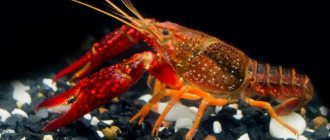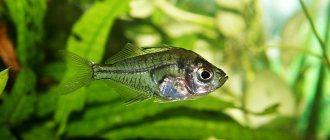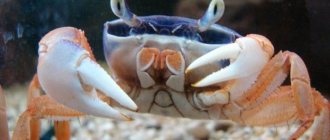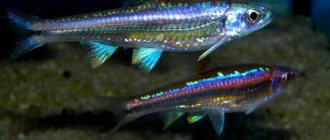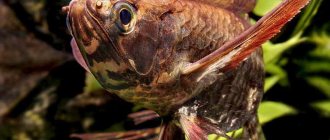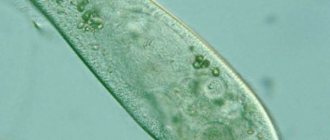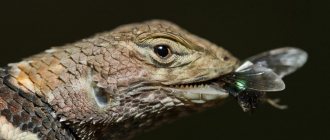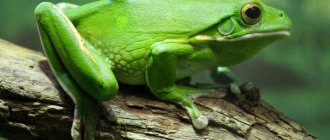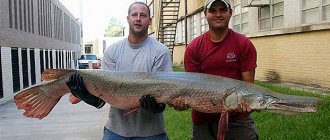They first appeared in Europe, where in 1877. Soon the sunfish began to breed in ponds, and once in the Danube, they settled in the lower reaches of rivers flowing into the northwestern part of the Black Sea region. The sun perch's excellent adaptability to changing living conditions has allowed them to become quite widespread throughout the waters of Europe.
The sun perch reaches a length of 15 to 30 cm. The male is brighter in color and has a black spot with a red border on the gill cover. In the female, the edging is usually absent or weakly expressed.
Sun perch continue to spread today. This is also facilitated by the fact that the fish reaches sexual maturity by the age of one year. Males actively guard a clutch of more than three hundred eggs.
Habitat
Currently, this fish of the perch family is found even on the middle reaches of the Dnieper. Almost all rivers and even reservoirs in Ukraine are rich in it. It easily tolerates significant increases and decreases in water temperature and can easily overwinter in a pond covered with ice.
American sunfish can be caught in Ukraine all year round. But it bites especially well in sunny weather. Apparently, this is how it got its original name. Living in rivers or lakes, sunfish always stay close to the shore. Accordingly, it is easier to detect it there than in the middle of the river. Preferring shallow depths - up to a maximum of two meters, sun perch moves in small schools, keeping the direction either along the cut of the grass or along the coastal edge. The fish seems to be patrolling its territory. In such a place, sunfish are caught easily and quickly. And some flocks, even occupying a certain area, do not leave it for a long time. Most often this is a place under bushes or overhanging trees, as well as a clearing in algae or reeds.
List of fish
The perch family has 9 genera and includes about 236 species. We will focus on the most common examples. Please note that this list is far from final, since our planet is full of mysteries, and not all species have been discovered and fully studied.
The main representatives of perch fish include:
- perches;
They are most widespread in the waters of North America, Asia and Europe.
- zander;
These fish occupy the second place in distribution. They can be found in Europe and Northern Asia.
- ruffs;
This species has a less widespread distribution. Ruffs swim only in areas of Europe and Northern Asia.
- chops;
- burshi;
- percarines.
These fish are caught with considerable frequency, they can be found in limited areas (on the Azov-Black Sea coast).
- peppers;
- ammocrypts;
- etheostomy.
The list is completed by rare species of the perch family that inhabit the vast waters of North America.
Fishing
Despite its small mouth, this greedy fish swallows even the fry of other inhabitants of the reservoir. Based on this, experienced fishermen use large hooks of a fairly large number - tenth - when catching American perch. The best treat for this fish is maggot , although when fly fishing with dry flies it swallows the hook almost completely. It must be said that some consider the sunfish to be a “trash” fish, which, quickly multiplying, begins to destroy the eggs of more valuable commercial species, thereby causing harm
Keeping in an aquarium
There is every reason to believe that the sunfish is an invasive fish species. Thanks to its insatiable appetite, the “American” is currently a real threat to European fish species. After all, the “sunny guest” fights with the aborigines not only for food, but also destroys their eggs and fry. The rapid reproduction of sunfish causes significant damage to the ecosystems of European rivers and reservoirs, and damages the number of commercial fish species. Due to its small size, the sunfish itself Perch is valued by aquarists and bred as an ornamental fish.
Rules for keeping in an aquarium:
- Fish in captivity are usually smaller than in nature and reach 15 cm in length. Still, for an aquarium, the sunfish is considered a large fish. Considering that the fish are schooling and the recommended number of fish in a school is at least 5 individuals, the required volume of the aquarium is 200–300 liters.
- A weekly water change is required, 30% of the total volume of the aquarium.
- Fish are very sensitive to oxygen starvation. Aeration should take place 14 hours a day.
- Sandy soil is required. Sand plays an important role in spawning.
- The type of plants in the aquarium does not matter. A strong root system is important, because perch can undermine plants.
- Water temperature +16–24 degrees Celsius. In winter, no higher than +20 degrees.
- Any peaceful species of fish, the size of which is at least 15 cm, can become neighbors of the perch.
Nutrition
The fish is voracious and is ready to feed on both live and dry food, and will not refuse herbal supplements. You shouldn't get carried away with dry food. Boiled rice and pearl barley are suitable as a vegetable component. Suitable live food: daphnia, bloodworms, worms (earthworms, dung), fly larvae, fish and shrimp meat, even boiled beef heart.
Breeding
To breed sunfish you need:
- Choose the most active pair of fish. It’s easy to find out when a fish is ready to spawn. Males become aggressive and dig holes in the ground for laying.
- Place the breeders in a separate 100 liter aquarium. The soil required is sandy with small pebbles in a layer of 8–10 cm. It is recommended to stand for the water. The optimal water temperature is +22–24 degrees. Immediately after jigging, the male digs a nest, and the female lays up to 300 eggs in several batches.
- Transfer producers to exclusively protein food in the form of worms.
- Place the female after spawning. It is not difficult to understand that spawning is over. If the male drives the female away from the nest, then the clutch is complete.
- The male is left for 2–4 days to care for the eggs. After the fry appear, the male is removed.
- Live dust feed is suitable as feed at the initial stage.
- The growth of the fry is uneven. Regular sorting is required.
The sun perch is a beautiful fish with an original coloring. The fish is in demand as a decorative species and is valued by aquarists. In the wild, it is considered a “weed” species and harms commercial fish species.
Sunny perch
Tackle
They say that the sun perch has proliferated so much that it can even be caught with a spinning rod. At the same time, he pecks often and greedily. Today it is caught very little, because, due to its small size, it is not a trophy. If the sunny perch does not respond to the spoon, then you need to try to mount the equipment, which is a small jig.
A crawler or earthworm attached to a hook is an attractive delicacy for this inhabitant of reservoirs. Such equipment helps to catch even very passive perch, regardless of where the fishing is carried out - in open water or on ice.
Feeding
In nature, they feed on a variety of small foods both on the surface of the water and on the bottom. Among their favorites: insects, mosquito larvae, small molluscs and crustaceans, worms, fry and even other small perches.
They are known to feed on small crayfish and sometimes small pieces of vegetation, as well as small frogs or tadpoles.
Sunfish that live in waters with larger gastropods have larger mouths and associated muscles for breaking the shells of larger gastropods
In the aquarium they are also carnivorous and prefer to eat insects, worms and small fish.
Americans write that newly caught individuals may refuse unfamiliar foods, but over time they can be trained to eat fresh shrimp, frozen bloodworms, krill, cichlid pellets, cereal and other similar products.
Fishing Features
Many people believe that the best season for catching sunfish is during the spawning season. During this period, the fish are clearly visible in shallow water. But if the moment is missed, and the American bass goes deeper, then determining its location becomes much more difficult. In this case, complementary feeding helps a lot. Those who purposefully go fishing for sunfish, before starting fishing, walk along the shore and throw a little bloodworm into the water. Feeding simply collects a huge amount of potential prey, and bites begin to follow after casting. Fishing with silicone bait is not recommended, since the mouth of the sunfish is very small, and it is difficult for the fish to swallow even inch twisters.
Fishing in winter
When there are sharp bites in winter, the fisherman has to very often put the next bait on the hook. Therefore, for more intensive fishing from ice at such “hot” spots, bait is better suited, which will attract the sun perch with its smell, as well as taste and game. Another prerequisite is that the bait stays well on the hook.
In the middle of winter, the sun perch sometimes takes it so carefully that the angler often does not notice the bite. In some cases, the fish, having taken the bait, rises up with it. Therefore, experienced fishermen must distinguish even the weakest bites in order to make a reliable hook.
It is better to catch perch in a darkened tent or “closely”, shading the hole with something. This makes it possible to clearly see what is happening under the ice layer. And if the water is also clear, then you can even see the fish swallowing the bait. If the bait is at a considerable depth or the reservoir is already cloudy, then, most likely, it will not be possible to observe such a picture. However, if you take a bait with a very bright color, it is possible to notice when it disappears.
When fishing for sunfish from the ice, the float is difficult to follow, so many anglers install a flashlight. If you raise the light source high, the hole will be better visible, regardless of the power, be it a small candle or a very large lantern. And the play of light and shine of the gear will attract fish such as sunfish.
Description of the species
The body of the Californian perch is quite high, slightly flattened on the sides, the average length of an adult is about 30 cm. The tail part is narrow with a short stem. The head of this aquatic inhabitant is large with very large eyes and the same mouth.
A fin stretches along the entire length of the back, its rays form prickly spines. On the edge of the gill covers, growths are formed, which in their shape and appearance resemble ears; as a rule, this is a black crust with a beautiful orange-red edging.
As for coloring, it can vary, it all directly depends on the habitat. But in general, the color of rainbow perch scales can vary from light silver to red-orange. It is the silvery fish that is commonly called moon perch.
In addition, the entire body is covered with a blue patterned mesh, reminiscent of a tiger pattern, which can be clearly seen in dim lighting. There are practically no gender differences, but, as a rule, the male individual is painted in brighter colors; as for the female, she does not have a gill growth, which the male always has.
Color depends on habitat
Sea or river (differences)
The key differences between sea and river representatives of perch are in the internal and external structure.
Sea fish have large protruding eyes that help orientate in the dark. The standard color is bright red. Specimens that swim closer to the shore have a darker color and small eyes. They number about 90 species. The lifespan of the inhabitants of the deep sea is 60 years, but some can live for 200 years. Most often, fish live in the Atlantic and Pacific oceans, the Barents, Black, and Norwegian seas. Sea fish have large protruding eyes that help orientate in the dark. The standard color is bright red. The most important difference is the presence of spiny fin rays, which can not only injure the skin, but also cause complications for many months. The toxin that the fish splashes out can be removed using ultraviolet light, in an alkaline environment, and when heated. Marine representatives are a more popular product for their taste and beneficial properties.
The river fish has a yellow-green color with dark transverse stripes located on the sides. The eyes are small, non-protruding. The life expectancy of these inhabitants is 15 years. The river species is found in smaller fresh water bodies and coastal areas of the seas. The tightly-fitting scales have non-poisonous thorns that can cut. Under natural conditions, they are hunted by a larger number of large predatory fish, herons, and otters. River meat is more dietary; it can be consumed by those who adhere to proper nutrition and watch their figure.
Carnivore or herbivore
After reading the proposed material, you can easily determine whether perch is a predatory fish or not.
Perch is a strong, voracious, predatory fish that stubbornly pursues its prey. He arranges underwater races until the fish ends up in his mouth. Smaller specimens are not inferior in agility and agility; they greedily hunt for food in the upper layers of water. There were cases when flocks of fry got carried away in pursuit and jumped ashore along with their prey. Many representatives of this species have a greenish color, which helps them camouflage among algae when hunting.
These predators lead an active lifestyle almost all year round. The feeding period for perches is spring and autumn. If the summer is unstable, the hot weather gives way to a sharp cold snap, perches also begin to actively hunt. During flowering and during the summer heat, the fish tries to hide in the depths and becomes calmer.
The predator feeds on everything; worms, leeches, frogs, and fry fall into the mouths of large inhabitants. Smaller ones love to feast on bloodworms, crustaceans and caviar.
Reproduction
The breeding season depends on the temperature of the water in which it lives. In the northern regions, as a rule, it begins in May and continues until August, and in warm areas from March to May.
Spawning occurs at a depth of 100 meters; the female releases eggs in portions, which are immediately picked up by the underwater current and carried hundreds of kilometers away.
Each egg contains a little oil, which allows it to constantly float on the surface of the water. Having hatched from the eggs, the fry first feed on plankton. They begin their lives far from their place of birth. Some species of these fish mark eggs traditionally, that is; on plants and stones.
Breeding
Congrio what kind of fish, benefits and harms, properties of shrimp fish
Once the water temperature reaches 13-17 °C in late spring or early summer, the males will begin to build nests. Nesting sites are usually in shallow water on a sandy or gravel lake bottom.
Males use their caudal fins to sweep out shallow oval holes that are approximately twice as long as the male itself. They remove debris and large stones from their nests using their mouths.
Nests are located in colonies. Males are energetic and aggressive, and defend their nests. Due to this aggressive behavior, breeding in an aquarium is difficult.
Females arrive after nest construction is completed. Females may not only spawn in one nest, and different females may use the same nest.
Females are capable of producing between 1,500 and 1,700 eggs, depending on their size and age.
Once released, the eggs adhere to gravel, sand, or other debris in the nest. Females leave the nest immediately after spawning, but males remain and protect their offspring.
The male guards them for about the first 11 to 14 days, returning the fry to the nest in his mouth if they become distracted.
The fry remain in or near the shallow water zone and grow to approximately 5 cm in their first year of life. Sexual maturity is usually reached by two years.
Cartilaginous or bone
Reading this material, one question remained open: perch fish can be classified as cartilaginous or bone class. Let us draw a specific conclusion based on the features of the anatomical structure.
They are classified as a bone class for many reasons. Bony fish are characterized by a bony skeleton and the presence of gill covers covering the gill slits.
The fish has a streamlined body shape that allows it to swim quickly underwater. The surface of representatives of this species is covered with scales, which are equipped with teeth or spines. A characteristic feature of perciformes is the presence of two dorsal fins with sharp spines. The swim bladder is separate from the intestine. The skull is predominantly elongated.
